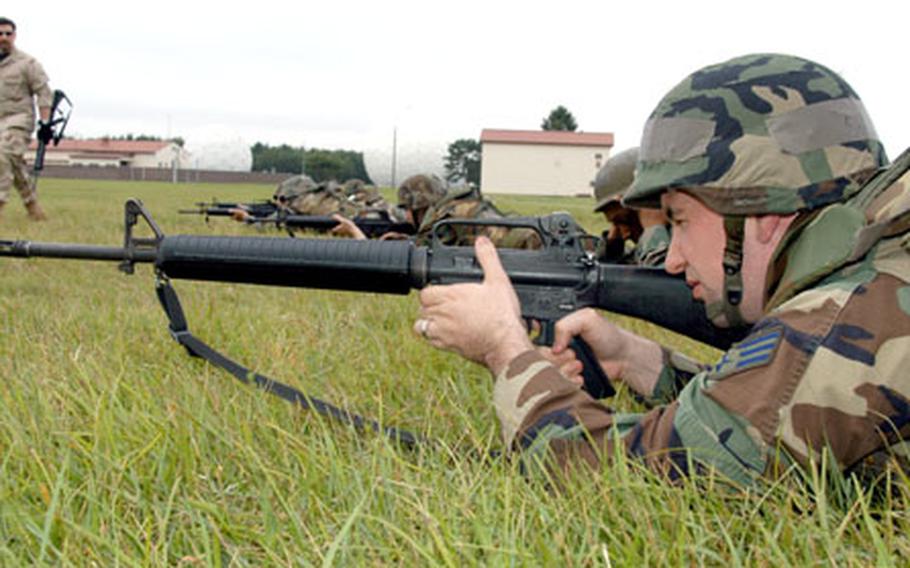
Senior Airman John Walker practices individual movement techniques with an M-16 during expeditionary combat skills training at Misawa Air Base, Japan, last week. (Jennifer H. Svan / Stars and Stripes)
MISAWA AIR BASE, Japan — In nature, there are no straight lines.
It’s an observation that makes sense but doesn’t occur to most. Except in Iraq, where chances are that a straight line in the sand conceals a wire attached to an improvised explosive device.
“What we want to do is stay out of the kill box,” a retired Army lieutenant colonel tells his class.
Welcome to the Air Force’s Combat 101.
Over the past two weeks, more than 350 airmen here exercised their brains and muscles during expeditionary combat skills training. Former military counterterrorism experts, now with Analytic Services Inc., taught the two days’ worth of intense academics and field drills.
Pacific Air Forces hired the Arlington, Va., firm to design and teach the classes after the Air Force began requiring that all airmen deploying to war zones receive a minimum 20 hours of combat training, the instructors said.
The trainers were at Misawa for the first time but have taught their course at other PACAF bases where airmen have deployed for an Aerospace Expeditionary Force rotation.
It’s Misawa’s turn in the hot zone now: Base officials said this week that more than 500 airmen have been identified for a possible deployment during the next 120-day AEF cycle from September to January.
Airman 1st Class Adrian Risby, 21, 373rd Intelligence Group, is one of them. He said if he goes, he’ll most likely be assigned to escort foreign national workers.
He called the training good but too short. “I’m going to be out there for four months. Two days of training isn’t adequate,” he said.
Many in the class agreed.
“It’s absolutely fantastic training,” said Capt. John Sackett, the next PACAF chaplain to deploy for an AEF. “It seems so critical. I’d just like to slow it down, break it up, spend more time talking about each part.”
Topics covered in the training include convoy operations, “search and challenge” procedures, unexploded ordnance sweeps, individual movement techniques, IEDs, M-16 usage and battlefield first aid. Airmen practiced crawling with weapon in hand low to the ground — what’s referred to as the “sniper drag,” which is used to close in on a target without being seen.
“If the side of your helmet isn’t grass-stained … then you’re doing it wrong,” said instructor Adam Smith, a former Navy SEAL.
The 40-hour course is squeezed into 20 hours. “We designed this course to be five days, but there’s so many people to catch up with this,” said William “Buddy” MacArthur, a retired Air Force tactical air controller. “We’re putting it out with a fire hose.”
The Air Force is playing catch-up. Its basic training currently is the shortest among the services; some airmen shoot their M-16s only about once every 24 months for qualification, if that.
“We had one lieutenant colonel who had not fired his M-16 in 18 years,” MacArthur said. “What happens if they end up on the battlefield and they have to defend their buddies?”
Unlike in wars past, airmen in Iraq and Afghanistan are doing jobs normally assigned to the Army, from driving convoys to guarding prisoners.
The combat training isn’t designed to mold airmen into infantrymen, instructors said, but to teach them skills to stay alive and not become a liability when working with Army, Marine Corps and Air Force Security Forces units.
“We’re just trying to teach them just enough that they can get out of the vehicle, get behind some cover and lay down enough suppressive fire that they can stay alive … and not hurt each other in the process,” said instructor Rod Propst, a retired Army lieutenant colonel. His mantra: “Stay alert, stay alive.”
Airmen identified specifically for convoy duty also will attend additional convoy training in the States, officials said.
For instance, Staff Sgt. Adam Varga, a 35th Logistics Readiness Squadron vehicle operator, who was the gunner on Army convoy escorts for eight months in Iraq, had two months of training in the States before deploying last year.
But any airman now in Iraq could find himself on a convoy, he said, and 20 hours of training just doesn’t cut it. “You need three days out in the field with this weapon,” he said of the M-16. “Everyone has to be qualified, but are they comfortable? Probably not.”
MacArthur said airmen will be expected to know how to move if they go out with other units. It will be difficult after only 20 hours of instruction, he said, but airmen still might outperform their Army counterparts if they use their skills and “just think.”
Or as Smith said: “We don’t have the benefit of 20 weeks of infantry training, but it isn’t rocket science.”